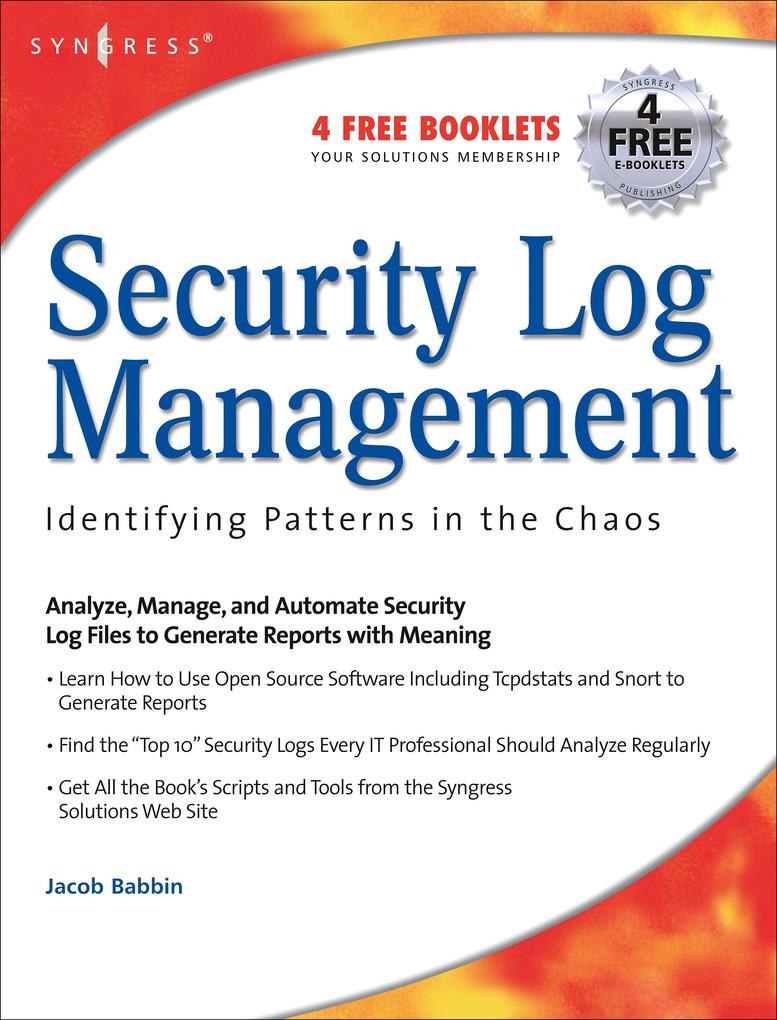This book teaches IT professionals how to analyze, manage, and automate their security log files to generate useful, repeatable information that can be use to make their networks more efficient and secure using primarily open source tools. The book begins by discussing the "Top 10 security logs that every IT professional should be regularly analyzing. These 10 logs cover everything from the top workstations sending/receiving data through a firewall to the top targets of IDS alerts. The book then goes on to discuss the relevancy of all of this information. Next, the book describes how to script open source reporting tools like Tcpdstats to automatically correlate log files from the various network devices to the "Top 10 list. By doing so, the IT professional is instantly made aware of any critical vulnerabilities or serious degradation of network performance. All of the scripts presented within the book will be available for download from the Syngress Solutions Web site. Almost every operating system, firewall, router, switch, intrusion detection system, mail server, Web server, and database produces some type of "log file. This is true of both open source tools and commercial software and hardware from every IT manufacturer. Each of these logs is reviewed and analyzed by a system administrator or security professional responsible for that particular piece of hardware or software. As a result, almost everyone involved in the IT industry works with log files in some capacity. * Provides turn-key, inexpensive, open source solutions for system administrators to analyze and evaluate the overall performance and security of their network* Dozens of working scripts and tools presented throughout the book are available for download from Syngress Solutions Web site. * Will save system administrators countless hours by scripting and automating the most common to the most complex log analysis tasks
Inhaltsverzeichnis
1;Cover;1 2;Contents;11 3;Foreword;17 4;Chapter 1 Log Analysis: Overall Issues;19 4.1;IT Budgets and Results: Leveraging OSS Solutions at Little Cost;20 4.2;Reporting Security Information to Management;23 4.3;Combining Resources for an Eye-in-the-Sky View;27 4.4;Blended Threats and Reporting;30 4.5;Conclusion;34 4.6;Code Solutions;34 4.7;Commercial Solutions: ArcSight and Netforensics;48 5;Chapter 2 IDS Reporting;55 5.1;Session/Flow Logging with Snort;57 5.2;Session/Flow Logging with Argus;62 5.3;Can You Determine When a DDoS/DoS Attack Is Occurring?;71 5.4;Using Snort for Bandwidth Monitoring;75 5.5;Using Bro to Log and Capture Application-Level Protocols;83 5.6;Tracking Users Web Activities with Bro;92 5.7;Using Bro to Gather DNS and Web Traffic Data;97 5.8;Using Bro for Blackholing Traffic to Malware-Infested Domains;108 5.9;Using Bro to Identify Top E-Mail Senders/Receivers;119 6;Chapter 3 Firewall Reporting;131 6.1;Firewall Reporting: A Reflection of the Effectiveness of Security Policies;132 6.2;The Supporting Infrastructure for Firewall Log Management;134 7;Chapter 4 Systems and Network Device Reporting;161 7.1;Web Server Logs;165 7.2;Recon and Attack Information;166 7.3;Correlating Data with the Host System;170 8;Chapter 5 Creating a Reporting Infrastructure;183 8.1;Creating IDS Reports from Snort LogsExample Report Queries;184 8.2;Creating IDS Reports from Bro LogsApplication Log Information;196 9;Chapter 6 Scalable Enterprise Solutions (ESM Deployments);211 9.1;What Is ESM?;214 9.2;When Deploying ESM Makes Sense;223 9.3;Which Security Reporting Tools to Aggregate into ESM;234 9.4;Special Considerations for Using ESM;245 9.5;Using ESM Reporting for Maximum Performance;238 9.6;Lessons Learned Implementing ESM;248 10;Chapter 7 Managing Log Files with Microsoft Log Parser;261 10.1;Log File Conversion;262 10.2;Log Rotation and Archival;277 10.3;Separating Logs;289 11;Chapter 8 Investigating Intrusions with Microsoft Log Parser;299 11.1;Locating Intrusions;300 1
1.2;Monitoring IIS;305 12;Chapter 9 Managing Snort Alerts with Microsoft Log Parser;323 12.1;Building Snort IDS Reports;324














